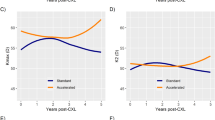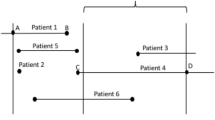Abstract
Objective
To define how estimates of keratoconus progression following collagen cross-linking (CXL) vary according to the parameter selected to measure corneal shape.
Materials and methods
We estimated progression following CXL in 1677 eyes. We compared standard definitions of keratoconus progression based on published thresholds for Kmax, front K2, or back K2, or progression of any two of these three parameters, with the option of an increased threshold for Kmax values ≥ 55D. As corneal thickness reduces unpredictably after CXL, it was excluded from the principal analysis. We then repeated the analysis using novel adaptive estimates of progression for Kmax, front K2, or back K2, developed separately using 6463 paired readings from keratoconus eyes, with a variation of the Bland–Altman method to determine the 95% regression-based limits of agreement (LoA). We created Kaplan-Meier survival plots for both standard and adaptive thresholds. The primary outcome was progression five years after a baseline visit 9–15 months following CXL.
Results
Progression rates were 8% with a standard (≥ 1.5D) threshold for K2 or 6% with the static multi-parameter definition. With a ≥ 1D threshold for Kmax, the progression was significantly higher at 29%. With adaptive Kmax or K2, the progression rates were similar (20%) but less than with the adaptive multi-parameter method (22%).
Conclusions
Estimates of keratoconus progression following CXL vary widely according to the reference criteria. Using adaptive thresholds (LoA) to define the repeatability of keratometry gives estimates for progression that are markedly higher than with the standard multi-parameter method.
This is a preview of subscription content, access via your institution
Access options
Subscribe to this journal
Receive 18 print issues and online access
$259.00 per year
only $14.39 per issue
Buy this article
- Purchase on Springer Link
- Instant access to full article PDF
Prices may be subject to local taxes which are calculated during checkout



Similar content being viewed by others
Data availability
Additional data are available from the corresponding author on reasonable request.
References
Papaliʼi-Curtin AT, Cox R, Ma T, Woods L, Covello A, Hall RC. Keratoconus prevalence among high school students in New Zealand. Cornea. 2019;38:1382–9.
Chan E, Chong EW, Lingham G, Stevenson LJ, Sanfilippo PG, Hewitt AW, et al. Prevalence of keratoconus based on Scheimpflug imaging: the raine study. Ophthalmology. 2021;128:515–21.
Godefrooij DA, de Wit GA, Uiterwaal CS, Imhof SM, Wisse RPL. Age-specific incidence and prevalence of keratoconus: a nationwide registration study. Am J Ophthalmol. 2017;175:169–72.
Tur VM, MacGregor C, Jayaswal R, O’Brart D, Maycock N. A review of keratoconus: diagnosis, pathophysiology, and genetics. Surv Ophthalmol. 2017;62:770–83.
Ferdi AC, Nguyen V, Gore DM, Allan BD, Rozema JJ, Watson SL. Keratoconus natural progression: a systematic review and meta-analysis of 11529 Eyes. Ophthalmology. 2019;126:935–45.
Caporossi A, Mazzotta C, Baiocchi S, Caporossi T. Long-term results of riboflavin ultraviolet a corneal collagen cross-linking for keratoconus in Italy: the Siena eye cross study. Am J Ophthalmol. 2010;149:585–93.
Gore DM, Leucci MT, Koay S-Y, Kopsachilis N, Nicolae MN, Malandrakis MI, et al. Accelerated pulsed high-fluence corneal cross-linking for progressive keratoconus. Am J Ophthalmol. 2021;221:9–16.
O’Brart DPS, Chan E, Samaras K, Patel P, Shah SP. A randomised, prospective study to investigate the efficacy of riboflavin/ultraviolet A (370 nm) corneal collagen cross-linkage to halt the progression of keratoconus. Br J Ophthalmol. 2011;95:1519–24.
Nicula C, Nicula D, Pop RN. Results at 7years after cross-linking procedure in keratoconic patients. J Fr Ophtalmol. 2017;40:535–41.
Larkin DFP, Chowdhury K, Burr JM, Raynor M, Edwards M, Tuft SJ, et al. Effect of corneal cross-linking versus standard care on keratoconus progression in young patients: The KERALINK Randomized Controlled Trial. Ophthalmology. 2021;128:1516–26.
Ferdi A, Nguyen V, Kandel H, Tan JCK, Arnalich-Montiel F, Abbondanza M, et al. Predictors of progression in untreated keratoconus: a Save Sight Keratoconus Registry study. Br J Ophthalmol. 2021;106:1206–11.
Achiron A, El-Hadad O, Leadbetter D, Hecht I, Hamiel U, Avadhanam V, et al. Progression of pediatric keratoconus after corneal cross-linking: a systematic review and pooled analysis. Cornea. 2022;41:874–8.
Ng SM, Ren M, Lindsley KB, Hawkins BS, Kuo IC. Transepithelial versus epithelium-off corneal crosslinking for progressive keratoconus. Cochrane Database Syst Rev. 2021;3:CD013512.
Flynn TH, Sharma DP, Bunce C, Wilkins MR. Differential precision of corneal pentacam HR measurements in early and advanced keratoconus. Br J Ophthalmol. 2016;100:1183–7.
Flockerzi E, Häfner L, Xanthopoulou K, Daas L, Munteanu C, Langenbucher A, et al. Reliability analysis of successive corneal visualization Scheimpflug technology measurements in different keratoconus stages. Acta Ophthalmol. 2022;100:e83–90.
Kreps EO, Jimenez-Garcia M, Issarti I, Claerhout I, Koppen C, Rozema JJ. Repeatability of the pentacam HR in various grades of keratoconus. Am J Ophthalmol. 2020;219:154–62.
Seiler TG, Mueller M, Mendes Baiao T. Repeatability and comparison of corneal tomography in mild to severe keratoconus between the anterior segment OCT MS-39 and Pentacam HR. J Refract Surg. 2022;38:250–5.
Greenstein SA, Shah VP, Fry KL, Hersh PS. Corneal thickness changes after corneal collagen crosslinking for keratoconus and corneal ectasia: one-year results. J Cataract Refract Surg. 2011;37:691–700.
Mencucci R, Paladini I, Virgili G, Giacomelli G, Menchini U. Corneal thickness measurements using time-domain anterior segment OCT, ultrasound, and Scheimpflug tomographer pachymetry before and after corneal cross-linking for keratoconus. J Refract Surg. 2012;28:562–6.
Shafik Shaheen M, Lolah MM, Piñero DP. The 7-year outcomes of epithelium-off corneal cross-linking in progressive keratoconus. J Refract Surg. 2018;34:181–6.
Tzamalis A, Diafas A, Vinciguerra R, Ziakas N, Kymionis G. Repeated corneal cross-linking (CXL) in keratoconus progression after primary treatment: updated perspectives. Semin Ophthalmol. 2021;36:526–30.
Bland JM. How do I estimate limits of agreement when the mean or SD of differences is not constant? https://www-users.york.ac.uk/~mb55/meas/glucose.htm (2009).
Flockerzi E, Elzer B, Daas L, Xanthopoulou K, Eppig T, Langenbucher A, et al. The reliability of successive Scheimpflug imaging and anterior segment optical coherence tomography measurements decreases with increasing keratoconus severity. Cornea. 2021;40:1433–9.
Vinciguerra R, Belin MW, Borgia A, Piscopo R, Montericcio A, Confalonieri F, et al. Evaluating keratoconus progression prior to crosslinking: maximum keratometry vs the ABCD grading system. J Cataract Refract Surg. 2021;47:33–9.
Lenk J, Herber R, Oswald C, Spoerl E, Pillunat LE, Raiskup F. Risk factors for progression of keratoconus and failure rate after corneal cross-linking. J Refract Surg. 2021;37:816–23.
Mazzotta C, Raiskup F, Hafezi F, Torres-Netto EA, Armia Balamoun A, Giannaccare G, et al. Long term results of accelerated 9 mW corneal crosslinking for early progressive keratoconus: the Siena Eye-Cross Study 2. Eye Vis. 2021;8:16.
Lombardo M, Serrao S, Lombardo G, Schiano-Lomoriello D. Two-year outcomes of a randomized controlled trial of transepithelial corneal crosslinking with iontophoresis for keratoconus. J Cataract Refract Surg. 2019;45:992–1000.
Iqbal M, Elmassry A, Saad H, Am Gad A, Ibrahim O, Hamed N, et al. Standard cross-linking protocol versus accelerated and transepithelial cross-linking protocols for treatment of paediatric keratoconus: a 2-year comparative study. Acta Ophthalmol. 2020;98:e352–62.
Jouve L, Borderie V, Sandali O, Temstet C, Basli E, Laroche L, et al. Conventional and iontophoresis corneal cross-linking for keratoconus: efficacy and assessment by optical coherence tomography and confocal microscopy. Cornea. 2017;36:153–62.
Shajari M, Kolb CM, Agha B, Steinwender G, Müller M, Herrmann E, et al. Comparison of standard and accelerated corneal cross‐linking for the treatment of keratoconus: a meta‐analysis. Acta Ophthalmol. 2019;97:e22–35.
Kobashi H, Tsubota K. Accelerated versus standard corneal cross-linking for progressive keratoconus: a meta-analysis of randomized controlled trials. Cornea. 2020;39:172–180.
Kandel H, Abbondanza M, Gupta A, Mills R, Watson AS, Petsoglou C, et al. Comparison of standard versus accelerated corneal collagen cross-linking for keratoconus: 5-year outcomes from the Save Sight Keratoconus Registry. Eye. 2023;8:95–102. https://doi.org/10.1038/s41433-023-02641-6.
Seifert FK, Theuersbacher J, Schwabe D, Lamm O, Hillenkamp J, Kampik D. Long-term outcome of corneal collagen crosslinking with riboflavin and UV-A irradiation for keratoconus. Curr Eye Res. 2022;47:1472–8.
Acknowledgements
Mary Fortune provided statistical advice. Moorfields Eye Charity is supported in part by the National Institute for Health Research (NIHR) Biomedical Research Centre based at Moorfields Eye Hospital NHS Foundation Trust and UCL Institute of Ophthalmology.
Funding
HM was funded by a Moorfields Eye Charity PhD Studentship (GR001147). NP is funded by a Moorfields Eye Charity Career Development Award (R190031A). ST, BA and DG acknowledge that a proportion of their financial support is from the Department of Health through the award made by the National Institute for Health Research to Moorfields Eye Hospital NHS Foundation Trust and University College London Institute of Ophthalmology for a Specialist Biomedical Research Centre for Ophthalmology. The sponsor or funding organisation had no role in the design or conduct of this research.
Author information
Authors and Affiliations
Contributions
OL, HM, ST, DG conceptualization; OL, HM, ML, ST, NP, DG methodology; HM, LK, ML, NP software; OL, HM, validation; HM, CB formal analysis; ML, NK, ST, BA, DG resources; HM, ML data curation; OL, HM, ST, DG writing; all authors approved the final draft.
Corresponding author
Ethics declarations
Competing interests
The authors declare no competing interests.
Additional information
Publisher’s note Springer Nature remains neutral with regard to jurisdictional claims in published maps and institutional affiliations.
Supplementary information
Rights and permissions
Springer Nature or its licensor (e.g. a society or other partner) holds exclusive rights to this article under a publishing agreement with the author(s) or other rightsholder(s); author self-archiving of the accepted manuscript version of this article is solely governed by the terms of such publishing agreement and applicable law.
About this article
Cite this article
Li, JP.O., Maile, H.P., Bunce, C. et al. A comparison of keratoconus progression following collagen cross-linkage using standard or personalised keratometry thresholds. Eye (2024). https://doi.org/10.1038/s41433-024-02994-6
Received:
Revised:
Accepted:
Published:
DOI: https://doi.org/10.1038/s41433-024-02994-6



